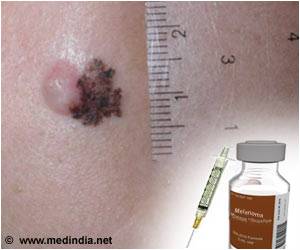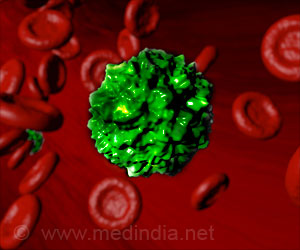Tumours with the highest number of mutations and those that have T cells present in the tumour microenvironment more responsive to immunotherapy.

‘Three types of tumour microenvironments were found; "immune desert", "T cell excluded tumours" and "T cell inflamed tumours"’





"Understanding why the remaining 70-80% are resistant would enable us to target the mechanism with an additional drug and extend the benefits of checkpoint inhibitors to more patients," said lead author Dr Sanjeev Mariathasan, Senior Scientist, Oncology Biomarker Department, Genentech, South San Francisco, US. The IMvigor210 study
The IMvigor210 biomarker study investigated the drivers of efficacy and primary resistance to the anti-PD-L1 checkpoint inhibitor atezolizumab in 300 patients with bladder cancer. They used a combination of methods including immunohistochemistry, genome sequencing, and RNA expression. The researchers found two drivers of efficacy and one driver of resistance. In terms of efficacy, tumours with the highest number of mutations - called a high mutation burden - were the most amenable to immunotherapy. Tumours that had T cells present in the tumour microenvironment were also more responsive to immunotherapy. Regarding resistance, tumours with high expression of the cytokine TGF-β tended to be unresponsive to immunotherapy. When the researchers dug deeper into the mechanisms of resistance, they found three types of tumour microenvironment:
1) "immune desert" with few T cells (25% of bladder cancers)
2) "T cell excluded tumours" in which T cells are stuck in the stromal microenvironment and do not penetrate the tumour (50%)
Advertisement
Mariathasan said that in "T cell excluded tumours", the tumour may secrete a factor that builds a collagen-rich fortified wall around the tumours. The stromal microenvironment is like a Velcro that T cells stick to and do not enter the tumour. High expression of TGF-β and TGF-β-induced stromal genes in these excluded tumours were associated with non-responders, suggesting that these may help to fortify the tumour against T cell penetration.
Advertisement
The researchers then examined whether inhibiting TGF-β activity could improve the efficacy of atezolizumab. A mouse model with the "T cell excluded tumour" phenotype was used to compare four treatments: isotype antibody (control group), anti-PD-L1 alone, anti-TGF-β alone, and the combination of anti-TGF-β plus anti-PD-L1. In the combination group, TGF-β activity in stromal cells was reduced, T cells penetrated into the centre of the tumour, and the tumour reduced in size.
Mariathasan said: "This suggests that giving anti-TGF-β and anti-PD-L1 together can remodel the stromal microenvironment and allow T cells into the tumour. The 'T cell excluded' phenotype is common in other cancers such as lung, pancreatic and colorectal, so this combination therapy could be tested in a wider group."
Commenting on the research, Professor Ignacio Melero, Senior Researcher, Centre for Applied Medical Research (CIMA), Pamplona, Spain, said: "Immunotherapy with PD-1/PD-L1 blockade is effective in a fraction of patients while it remains ineffective or suboptimal in most patients. It is key to identify the factors that impede more generalised benefit."
"TGF-β is a soluble protein that is known to suppress immune responses through a variety of mechanisms," continued Melero. "In this work, analysis of gene expression in clinical trial biopsies indicated that the gene signature of active TGF-β is in action in a fraction of bladder carcinoma patients who do not respond to PD-L1 blockade. In fact this seems to correlate with the inability of T killer lymphocytes to penetrate into the cancerous tissue. Moreover, experiments were undertaken in a transplantable breast cancer mouse model to see if TGF-β blockade is synergistic with PD-1/PD-L1 and it seems to be the case at least in that model."
Clinical implications and further research
Regarding the potential clinical implications of the findings, Melero said: "TGF-β has been pursued as a pharmacological target in cancer therapy research for some time. Inhibitors come in the form of neutralising monoclonal antibodies and signalling inhibitors (SMAD inhibitors). These molecules are in clinical trials but have not yielded remarkable success because of efficacy and safety constraints. It is interesting to know that perhaps we can identify, by means of gene signatures, a fraction of patients in whom TGF-β is the dominant mechanism and focus on synergistic combinations blocking PD-1 and TGF-β simultaneously."
When it comes to the need for further research, Melero said: "In bladder cancer it makes sense to design and implement a clinical trial that would select patients based on a TGF-β signature and treat them with an anti-TGF-β agent plus PD-1 or PD-L1 blockade. Better anti-TGF-β agents need to be developed for use combination with immunotherapy agents."
George Coukos, Congress Co-Chair, Professor and Director, Department of Oncology, Centre Hospitalier Universitaire Vaudois (CHUV) and University of Lausanne (UNIL), Lausanne, Switzerland, said the research had two main implications: "First of all it explains why T cells are perhaps retained in the stroma and are not able to move into the tumour. Most importantly, it opens the door for improving therapeutic responses to PD-1/PD-L1 blockade by simultaneously targeting the TGF-β pathway."
Coukos said a clinical study was needed combining PD-1 or PD-L1 blockade with TGF-β blockade in bladder cancer patients with the "T cell excluded tumour" phenotype, and then in other cancers with the same phenotype. "The T cell excluded tumours are the low hanging fruit in terms of clinical opportunity," he said. "At the basic research level, we need to better understand why tumours establish this barrier to T cell infiltration, how it is mediated, what role the stromal fibroblasts play, and how the immune excluded phenotype gets orchestrated at the tumour site in order to escape immune recognition."
Source-Eurekalert















